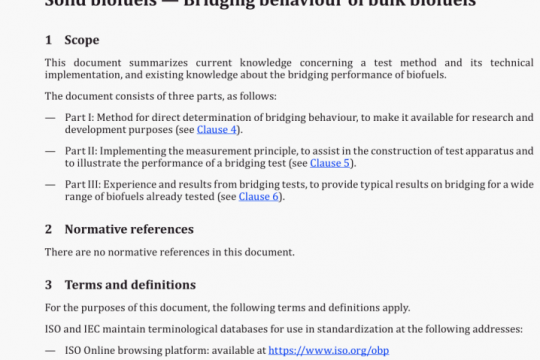ISO 18219-2 pdf free download
ISO 18219-2-2021 pdf free download.Leather一Determination of chlorinated hydrocarbons in leather – Part 2: Chromatographic method for middle-chain chlorinated paraffins (MCCPs).
This document specifies a chromatographic method to determine the amount of middle-chain chlorinated paraffins (MCCPs) C14 to C17 in processed and unprocessed leathers.
2 Normative references
The following documents are referred to in the text in such a way that some or all of their content constitutes requirements of this document. For dated references, only the edition cited applies. For undated references, the latest edition of the referenced document (including any amendments) applies.
ISO 2418, Leather — Chemical, physical and mechanical and fastness tests — Sampling location ISO 4044, Leather — Chemical tests — Preparation of chemical test samples
3 Terms and definitions
No terms and definitions are listed in this document.
ISO and IEC maintain terminological databases for use in standardization at the following addresses:
— ISO Online browsing platform: available at https://www.iso.org/obp
— I EC Electropedia: available at http://www.electropedia.org/
4 Principle
The test sample is extracted using n-hexane at 60 °C in an ultrasonic bath for 60 mm. After a sulfuric acid clean-up, an aliquot is then analysed using a gas chromatograph coupled to a mass selective detector with chemical ionization (GC-ECNI-MS).
A liquid chromatography system single quad (LC-MS) or with triple quad mass spectrometry (ICMS/MS), as described in Annex..B, can also be used if the user has demonstrated that the accuracy of measurement is equivalent to that of the GC-ECNI-MS method.
In some cases when determining MCCPs using the GC-ECNI-MS method, the presence of sulfochlorinated paraffins and equivalent chain-length chioroalkenes can cause interference. Annex B proposes a LCMS/MS application method that aims to give a better resolution and eliminates possible false positives determined with the GC-ECN I-MS method.
5 Apparatus and materials
Use normal laboratory apparatus and, in particular, the following.
8.2 Extraction of leather
Weigh (0,5 ± 0,001) g test leather sample with the analytical balance (51) into the sealable vessel (5.2).
Add 9,9 ml n-hexane (J.) and 100 il internal standard (2) and seal the vessel. Extract the sample at
(60 ± 5) °C in an ultrasonic bath (5) for (60 ± 2) mm. Cool down to room temperature (less than 27 °C).
8.3 Sulfuric acid clean-up
Add a 5 ml aliquot of the extracted hexane solution to a tight sealable vessel (52) and add 1 ml sulfuric acid (,4). Shake the vessel (5,7) for 10 mm. After separating of the phases (optionally with centrifugation), I ml of the hexane phase shall be taken for analysis.
8.4 GC-ECNI-MS Determination
The solution is analysed using GC-ECN I-MS (5k). An example of a suitable GC-ECN I-MS method is given in Annex A.
9 Expression of results
9.1 Evaluation
The peak shape evaluation (PSE) have been successfully tested and used. The integration shall be done with PSE, in accordance with examples presented in Annex C.
Peak areas from the four quantification masses of the standard are summed up and equated with standard concentration. Peak areas of the samples are summed up too and the concentration is calculated with the response of the standard.
To check the linearity of the analytical system, a calibration standard as reference standard is analysed after each ten samples and at the end of the sequence. The deviation in reference to the calibration standard should be within ± 20 %, otherwise the analytical system has to be checked before retrying the analysis.
Sample extract should always be diluted in the concentration range of the standard.
The integration of the samples shall only be done in the retention time window of the standard.
9.2 Ions used for quantification
Table A.1 lists the ions used for the quantification of MCCPs and the ions used for the internal standard lindane.
Sum up the quantifier peak areas from the standard and equate with the standard concentration. Also sum up the quantifier peak areas of the sample and calculate the concentration with responses of the calibration standards.
To get a quantitative result, each peak area of the extract chromatogram has to be below the highest calibration point. If not, dilute the extract with IS solution (B2) in the range or specify that the result is bigger than the calculate result.
9.3 Interference to MCCPs determination
Quantifier m/z (mass-to-charge ratio) ions 431 and 445 shall be quantified only if their area is above
10 % of the quantifier m/z ions 403 or 417 and the masses are not different (peak shape evaluation), see
C.3 and Figure C.3.
C17C17 quantifier (m/z 445) shows very low response and an overlay with SCCPs ions, therefore areas should be rejected if interference from SCCPs is noticed.ISO 18219-2 pdf download.




